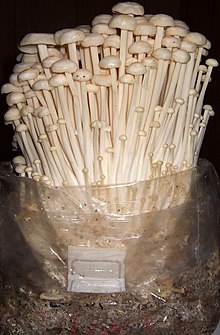Flammulina filiformis: Difference between revisions
Citation bot (talk | contribs) Add: s2cid, doi-access, pmc, pmid, page, volume. | Use this bot. Report bugs. | Suggested by Abductive | #UCB_webform 3659/3850 |
m proper noun casing: East Asia |
||
| Line 12: | Line 12: | ||
'''''Flammulina filiformis''''' is a species of [[agaric]] (gilled mushroom) in the [[family (biology)|family]] [[Physalacriaceae]]. It is well known for its role in [[Japanese cuisine]], where it is called '''enokitake''' (榎茸, エノキタケ, {{IPA-ja|enoki̥ꜜtake}})<ref>{{cite web|title=enokitake|url=http://dictionary.reference.com/browse/enokitake|work=Dictionary.com|publisher=Dictionary.com, LLC|access-date=14 May 2012|author=Dictionary.com|year=2012}}</ref> |
'''''Flammulina filiformis''''' is a species of [[agaric]] (gilled mushroom) in the [[family (biology)|family]] [[Physalacriaceae]]. It is well known for its role in [[Japanese cuisine]], where it is called '''enokitake''' (榎茸, エノキタケ, {{IPA-ja|enoki̥ꜜtake}})<ref>{{cite web|title=enokitake|url=http://dictionary.reference.com/browse/enokitake|work=Dictionary.com|publisher=Dictionary.com, LLC|access-date=14 May 2012|author=Dictionary.com|year=2012}}</ref> |
||
and is widely cultivated in |
and is widely cultivated in East Asia. Until recently, the species was considered to be conspecific with the European ''[[Flammulina velutipes]]'', but distinct.<ref name="Wang"/> |
||
==Taxonomy== |
==Taxonomy== |
||
Revision as of 05:50, 23 September 2022
| Enokitake | |
|---|---|

| |
| Cultivated Flammulina filiformis | |
| Scientific classification | |
| Domain: | Eukaryota |
| Kingdom: | Fungi |
| Division: | Basidiomycota |
| Class: | Agaricomycetes |
| Order: | Agaricales |
| Family: | Physalacriaceae |
| Genus: | Flammulina |
| Species: | F. filiformis
|
| Binomial name | |
| Flammulina filiformis (Z.W. Ge, X.B. Liu & Zhu L. Yang) P.M. Wang, Y.C. Dai, E. Horak & Zhu L. Yang (2018)
| |
| Synonyms | |
| |
Flammulina filiformis is a species of agaric (gilled mushroom) in the family Physalacriaceae. It is well known for its role in Japanese cuisine, where it is called enokitake (榎茸, エノキタケ, Japanese pronunciation: [enoki̥ꜜtake])[1] and is widely cultivated in East Asia. Until recently, the species was considered to be conspecific with the European Flammulina velutipes, but distinct.[2]
Taxonomy
Flammulina filiformis was originally described from China in 2015 as a variety of F. velutipes, based on ITS sequences.[3] Further molecular research using a combination of different sequences has shown that F. filiformis and F. velutipes are distinct and should be recognized as separate species.[2]
Vernacular names
The names enokitake (榎茸、エノキタケ), enokidake (榎茸、エノキダケ) and enoki (榎、エノキ) are derived from the Japanese language. In Mandarin Chinese, the mushroom is called 金針菇 (jīnzhēngū, "gold needle mushroom") or 金菇 (jīngū, "gold mushroom"). In India it is called futu, in Korean, it is called paengi beoseot (팽이버섯) which means "mushroom planted near catalpa", and nấm kim châm in Vietnamese.
Description
Basidiocarps are agaricoid and grow in clusters. Individual fruitbodies are up to 50mm (2 in) tall, the cap convex at first, becoming flat when expanded, up to 45mm (1.75 in) across. The cap surface is smooth, viscid when damp, ochraceous yellow to yellow-brown. The lamellae (gills) are cream to yellowish white. The stipe (stem) is smooth, pale yellow at the apex, yellow-brown to dark brown towards the base, lacking a ring. The spore print is white, the spores (under a microscope) smooth, inamyloid, ellipsoid to cylindical, c. 5 to 7 by 3 to 3.5μm.[2]
There is a significant difference in appearance between wild and cultivated basidiocarps. Cultivated enokitake are not exposed to light, resulting in white or pallid fruitbodies with long stipes and small caps.
Habitat and distribution
The fungus is found on dead wood of Betula platyphylla, Broussonetia papyrifera, Dipentodon sinicus, Neolitsea sp., Salix spp, and other broad-leaved trees.[2] It grows naturally in China, Korea, and Japan.
Cultivation and food
Flammulina filiformis has been cultivated in China since 800 AD.[4] Commercial production in China was estimated at 1.57 million tonnes per annum in 2010, with Japan producing an additional 140,000 tonnes per annum.[5] The fungus can be cultivated on a range of simple, lignocellulosic substrates including sawdust, wheat straw, and paddy straw.[6] Enokitake are typically grown in the dark, producing pallid fruitbodies having long and narrow stipes with undeveloped caps. Exposure to light results in more normal, short-stiped, coloured fruitbodies.[6]
Cultivated F. filiformis is sold both fresh and canned. The fungus has a crisp texture and can be refrigerated for approximately one week. It is a common ingredient for soups, especially in East Asian cuisine, but can be used for salads and other dishes.
See also
References
- ^ Dictionary.com (2012). "enokitake". Dictionary.com. Dictionary.com, LLC. Retrieved 14 May 2012.
- ^ a b c d Wang, Pan Meng; Liu, Xiao Bin; Dai, Yu Cheng; Horak, Egon; Steffen, Kari; Yang, Zhu L. (September 2018). "Phylogeny and species delimitation of Flammulina: taxonomic status of winter mushroom in East Asia and a new European species identified using an integrated approach". Mycological Progress. 17 (9): 1013–1030. doi:10.1007/s11557-018-1409-2. S2CID 49299638.
- ^ "Species diversity of Flammulina in China: new varieties and a new record". Mycosystema. 34 (4): 600. 2015. doi:10.13346/j.mycosystema.150080.
{{cite journal}}: Cite uses deprecated parameter|authors=(help) - ^ "Golden needle mushroom: a culinary medicine with evidenced-based biological activities and health promoting properties". Frontiers in Pharmacology. 7: 474. 2016. doi:10.3389/fphar.2016.00474. PMC 5141589. PMID 28003804.
{{cite journal}}: Cite uses deprecated parameter|authors=(help) - ^ Royse DJ (2014). "A Global Perspective on the High Five: Agaricus, Pleurotus, Lentinula, Auricularia & Flammulina" (PDF). Proceedings of the 8th International Conference on Mushroom Biology and Mushroom Products (ICMBMP8).
- ^ a b "Agronomic and environmental factors affecting cultivation of the winter mushroom or Enokitake: achievements and prospects". Applied Microbiology and Biotechnology. 103 (6): 2469–2481. 2019. doi:10.1007/s00253-019-09652-y. PMID 30685812. S2CID 59273677.
{{cite journal}}: Cite uses deprecated parameter|authors=(help)
